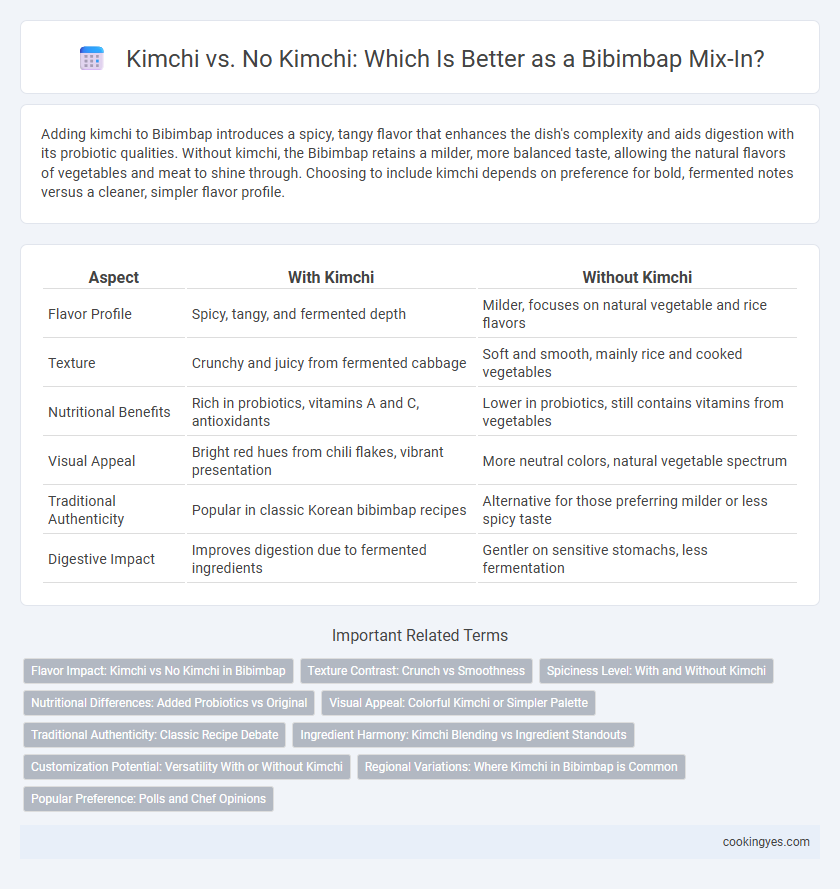Adding kimchi to Bibimbap introduces a spicy, tangy flavor that enhances the dish's complexity and aids digestion with its probiotic qualities. Without kimchi, the Bibimbap retains a milder, more balanced taste, allowing the natural flavors of vegetables and meat to shine through. Choosing to include kimchi depends on preference for bold, fermented notes versus a cleaner, simpler flavor profile.
Table of Comparison
| Aspect | With Kimchi | Without Kimchi |
|---|---|---|
| Flavor Profile | Spicy, tangy, and fermented depth | Milder, focuses on natural vegetable and rice flavors |
| Texture | Crunchy and juicy from fermented cabbage | Soft and smooth, mainly rice and cooked vegetables |
| Nutritional Benefits | Rich in probiotics, vitamins A and C, antioxidants | Lower in probiotics, still contains vitamins from vegetables |
| Visual Appeal | Bright red hues from chili flakes, vibrant presentation | More neutral colors, natural vegetable spectrum |
| Traditional Authenticity | Popular in classic Korean bibimbap recipes | Alternative for those preferring milder or less spicy taste |
| Digestive Impact | Improves digestion due to fermented ingredients | Gentler on sensitive stomachs, less fermentation |
Flavor Impact: Kimchi vs No Kimchi in Bibimbap
Adding kimchi to bibimbap intensifies the flavor profile with its spicy, tangy, and fermented notes, creating a robust and dynamic taste experience. Without kimchi, bibimbap relies on the natural sweetness of vegetables and the umami from gochujang, resulting in a milder, more balanced flavor. The presence of kimchi introduces a pungent complexity that enhances the overall depth and contrast in each bite.
Texture Contrast: Crunch vs Smoothness
Adding kimchi to bibimbap introduces a vibrant crunch that contrasts with the dish's otherwise smooth textures from rice and sauteed vegetables. The fermented cabbage's crispness enhances the overall mouthfeel, creating a dynamic blend of textures that elevates every bite. Without kimchi, bibimbap maintains a consistently soft and creamy texture, emphasizing the harmony of tender ingredients but lacking the sharp textural contrast kimchi provides.
Spiciness Level: With and Without Kimchi
Bibimbap with kimchi offers a heightened spiciness level due to the fermented chili peppers in kimchi, enhancing the dish's bold and tangy flavor profile. Without kimchi, bibimbap presents a milder taste that allows the natural sweetness of vegetables and seasoned rice to stand out. The choice of including kimchi directly influences the overall heat intensity, catering to preferences ranging from mild to spicy.
Nutritional Differences: Added Probiotics vs Original
Incorporating kimchi into bibimbap enhances the nutritional profile by introducing probiotics that support gut health and digestion, unlike the original bibimbap which lacks these beneficial bacteria. Kimchi also contributes essential vitamins such as vitamin C and carotenoids, boosting the antioxidant capacity of the dish. Without kimchi, bibimbap remains a rich source of protein and fiber but misses the digestive aids and immune-boosting properties linked to fermented foods.
Visual Appeal: Colorful Kimchi or Simpler Palette
Adding kimchi to Bibimbap enhances visual appeal with vibrant reds and oranges that contrast beautifully against the greens, whites, and yellows of the vegetables and rice. A simpler palette without kimchi emphasizes the natural hues of each ingredient, creating a clean and minimalist presentation. The choice impacts not only flavor but also the overall aesthetic, influencing how appetizing the dish appears.
Traditional Authenticity: Classic Recipe Debate
Bibimbap traditionally combines rice, vegetables, and gochujang without kimchi mixed in, preserving the classic balance of flavors rooted in Korean culinary heritage. Authentic recipes emphasize separately serving kimchi as a side dish to maintain textural contrast and prevent overwhelming the harmonious taste profile. Adding kimchi directly into Bibimbap remains a contemporary adaptation rather than a reflection of the traditional, time-honored preparation.
Ingredient Harmony: Kimchi Blending vs Ingredient Standouts
Kimchi adds a spicy, tangy dimension that enhances the overall flavor profile of bibimbap, creating a harmonious blend with the rice, vegetables, and gochujang sauce. Without kimchi, the distinct textures and natural flavors of each ingredient stand out more prominently, allowing the freshness of vegetables and the nuttiness of sesame oil to shine. The choice between kimchi inclusion or exclusion in bibimbap impacts the balance between a unified taste experience and highlighting individual ingredient characteristics.
Customization Potential: Versatility With or Without Kimchi
Bibimbap offers exceptional customization potential, allowing diners to tailor their bowls with or without kimchi to suit individual flavor preferences. Including kimchi introduces a spicy, fermented tang that enhances complexity and depth, while omitting it highlights the fresh vegetable textures and savory proteins. This versatility ensures Bibimbap remains adaptable to dietary restrictions, personal taste, and regional variations, maintaining its appeal across diverse palates.
Regional Variations: Where Kimchi in Bibimbap is Common
In Korean cuisine, the inclusion of kimchi in bibimbap varies significantly by region, with provinces like Jeolla and Gyeongsang showcasing a preference for kimchi as a common mix-in due to their rich kimchi-making traditions. In Jeolla, the abundance of kimchi varieties enhances the dish's spicy and tangy profile, complementing the mixed rice and vegetables. Conversely, in regions such as Seoul and Gangwon, bibimbap is frequently served without kimchi mixed in, highlighting the dish's balance of fresh ingredients and emphasizing texture over fermented flavors.
Popular Preference: Polls and Chef Opinions
Polls indicate that a significant majority of bibimbap enthusiasts prefer adding kimchi, citing its spicy, tangy flavor as a perfect contrast to the dish's savory elements. Top Korean chefs recommend kimchi inclusion to enhance umami depth and introduce probiotic benefits, emphasizing its role in balancing textures. However, a minority favor no kimchi to preserve the original harmony of ingredients, underscoring personal taste variation in bibimbap customization.
Kimchi addition vs No kimchi for Bibimbap mix-in Infographic

 cookingyes.com
cookingyes.com